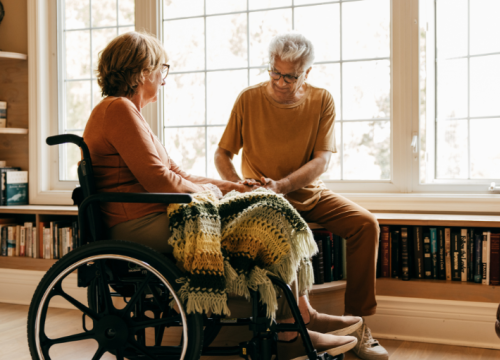How to Address and Prevent Care Partner Burnout

The role of a care partner can be very meaningful, but the stress and change of caring for someone can be emotionally draining as well. Care partner burnout occurs when the care partner feels overwhelmed and begins to remove themselves from their role, leading to the care partner no longer caring for themself or their mental wellness.
A care partner who is experiencing burnout may isolate and lack the energy to care for their loved one. Knowing how to recognize burnout can help you prevent and treat it.
Care Partner Strain vs. Care Partner Burnout
Care partner strain: when a care partner begins to lack empathy for the person they care for. Precedes care partner burnout.
Care partner burnout: when a care partner feels overwhelmed and begins to remove themselves from their role, leading to the care partner no longer caring for themself or their mental wellness.
Learn more! Register for our Care Partner Program: What is Care Partner Burnout?
Care Partner Strain
Before burnout comes care partner strain — when a care partner begins to lack empathy for the person they are caring for. Through emotional exhaustion and frustration, a care partner begins to lose compassion for their loved one. Strain can lead to care partner burnout.
Oftentimes the higher the care partner strain, the lower the quality of care. The care partner and the person being cared for both suffer when the care partner is experiencing care partner strain. A social worker or physician may be the best person to identify care partner strain and give you strategies to help you recover.
If care partner strain starts to progress to burnout, take a minute to identify what you are experiencing. Begin to incorporate a self-care plan if you have not already done so. It is important to consider how you will practice and make time for self-care while also taking care of your loved one.
Recognizing Care Partner Burnout
There are multiple ways to measure and identify care partner burnout. It is important to first recognize you are experiencing care partner burnout because you can then move on to treating it. Signs of care partner burnout include:
- Fatigue
- Anger
- Withdrawal
- Aches and pains
- Cognitive changes
Prioritizing Your Needs
You cannot pour from an empty cup. It is normal to feel stress and guilt when trying to prioritize your needs as a care partner. You must give yourself time and rest to fill up. Here are suggestions to help you find the energy to care for yourself:
- Ask family and friends for support
- Go to therapy on a consistent basis (not sure where to start? Read this article on tips for finding your ideal mental health counselor)
- Work with a social worker who can recommend resources
- Look into respite care
- Explore in-home care support options
Respite care can be a viable option. It can range from a few hours to longer and can be achieved in a variety of ways. Respite care looks different for everyone depending on financial situations and individual needs. Facilities often offer respite care packages that give you a place for your loved one to stay if you need time for yourself. This is typically private pay and will not be an option for everyone. If finances are tight, consider asking loved ones to chip in towards your “respite fund” for any holiday you celebrate where gifts are exchanged.
You can also explore in-home care support, which is usually for shorter periods of time. This can be a secondary care partner. A secondary care partner can either be a professional, through an agency or a family member or friend you ask to help.
Asking for Help
Be honest about your needs, it is okay and healthy to ask for help. Remember that just because you need help does not mean you are failing as a care partner. You do not have to do it all by yourself; caregiving is a team sport. The best way to prevent care partner burnout is to have a community of support.
Explore Parkinson’s Foundation resources that can help:
- The Helpline 1-800-4PD-INFO (1-800-473-4636) can answer your care questions and help you find additional resources and support groups.
- PD Conversations is a great place to discuss and share with other care partners in the PD community.
Take A Minute
Are you experiencing care partner strain or burnout? If so, say some of your stresses out loud. Next, take a few minutes to think about what simple self-care activity you can implement today, like going for a brisk walk or spending two minutes focused on your breathing.
When you take on the care partner role, you may put the person you are caring for as the top priority. When all your energy is going to someone else, you may stop caring for yourself. Try shifting your perspective. Caring for someone with Parkinson’s is a role, and it is not the only role you have in life. Tend to your self-care, find what feels safe, and build a community.
Recovering from Burnout
You can always come back from care partner burnout but try to make adjustments to prevent burnout in the future. These changes may include more time to practice self-care, better communication between you and your loved one, and seeking professional help.
Be intentional about your personal healing. To prevent burnout in the future, find a support community that works for you.
This article is based on the Care Partner Program: What is Care Partner Burnout? presented by Lance M. Wilson, MSS, LSW, C-SWHC, ASW-G, Neuroscience Medical Social Worker. Start this course today!
Sign up for self-paced courses designed for care partners through our Care Partner Program.
Related Blog Posts

3 Essential Resources for 3 Different Kinds of Care Partners

Advanced Parkinson’s Care: Practical Ways to Help Your Loved One
